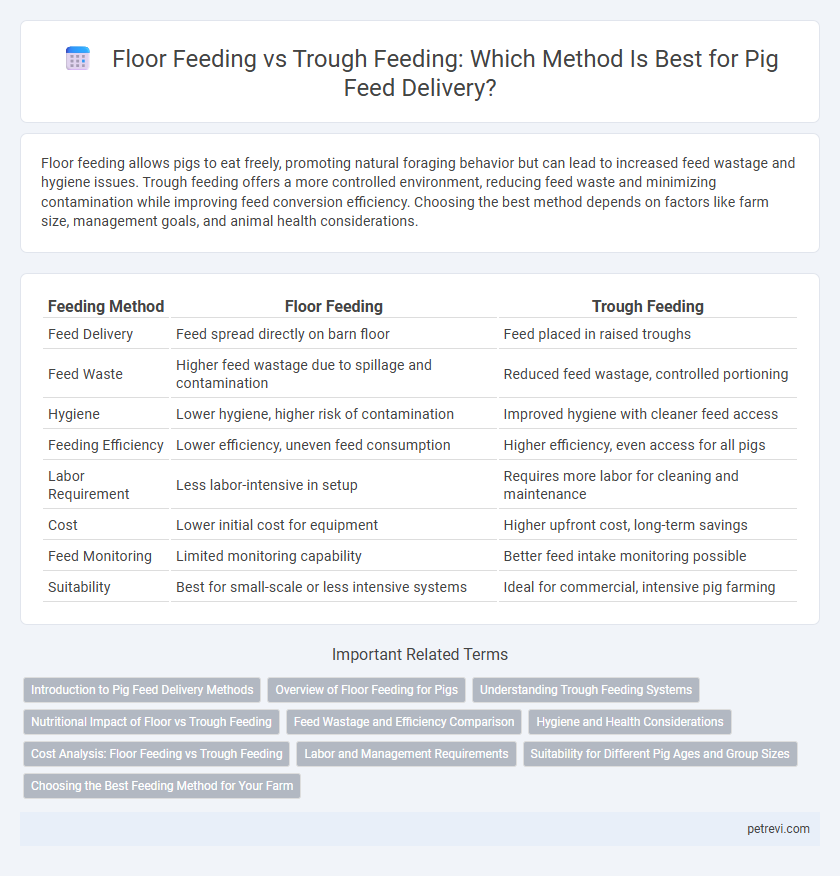Floor feeding allows pigs to eat freely, promoting natural foraging behavior but can lead to increased feed wastage and hygiene issues. Trough feeding offers a more controlled environment, reducing feed waste and minimizing contamination while improving feed conversion efficiency. Choosing the best method depends on factors like farm size, management goals, and animal health considerations.
Table of Comparison
| Feeding Method | Floor Feeding | Trough Feeding |
|---|---|---|
| Feed Delivery | Feed spread directly on barn floor | Feed placed in raised troughs |
| Feed Waste | Higher feed wastage due to spillage and contamination | Reduced feed wastage, controlled portioning |
| Hygiene | Lower hygiene, higher risk of contamination | Improved hygiene with cleaner feed access |
| Feeding Efficiency | Lower efficiency, uneven feed consumption | Higher efficiency, even access for all pigs |
| Labor Requirement | Less labor-intensive in setup | Requires more labor for cleaning and maintenance |
| Cost | Lower initial cost for equipment | Higher upfront cost, long-term savings |
| Feed Monitoring | Limited monitoring capability | Better feed intake monitoring possible |
| Suitability | Best for small-scale or less intensive systems | Ideal for commercial, intensive pig farming |
Introduction to Pig Feed Delivery Methods
Floor feeding allows pigs to eat directly from the pen floor, promoting natural foraging behavior but can lead to feed wastage and hygiene issues. Trough feeding provides a designated feeding area, improving feed efficiency, reducing contamination risks, and enabling better portion control. Both methods impact pig growth performance, health management, and overall farm productivity.
Overview of Floor Feeding for Pigs
Floor feeding for pigs involves distributing feed directly onto the barn floor, allowing pigs to forage naturally and select their preferred feed particles. This method promotes natural feeding behaviors and social interaction but may lead to increased feed wastage and hygiene challenges compared to trough feeding. Floor feeding is often chosen for its simplicity and low equipment cost, though it requires careful management to minimize contamination and ensure equitable feed access.
Understanding Trough Feeding Systems
Trough feeding systems offer precise feed distribution, minimizing waste and ensuring uniform access for pigs, which promotes consistent growth rates and healthier livestock. These systems can be adjusted to control feed intake, reducing the risk of overfeeding and improving feed conversion efficiency compared to floor feeding methods. Properly designed trough feeders also facilitate better hygiene and easier cleaning, lowering the chances of feed contamination and disease transmission among pigs.
Nutritional Impact of Floor vs Trough Feeding
Floor feeding in pigs often leads to increased feed wastage and contamination, reducing nutrient intake efficiency and potentially causing uneven growth rates. Trough feeding enhances controlled portion delivery, minimizing feed spillage and promoting consistent nutrient absorption by ensuring pigs consume formulated diets as intended. Optimizing feed delivery methods directly influences nutrient bioavailability, growth performance, and overall swine health outcomes.
Feed Wastage and Efficiency Comparison
Floor feeding in pig feed delivery often results in higher feed wastage due to spillage and contamination, leading to decreased feed efficiency. Trough feeding systems minimize feed loss by containing the feed in designated areas, promoting better portion control and cleaner consumption. Research indicates trough feeding can improve feed conversion ratios by up to 15%, enhancing overall productivity and cost-effectiveness on pig farms.
Hygiene and Health Considerations
Floor feeding in pig production can lead to increased contamination from feces and urine, posing significant risks for disease transmission and poor hygiene. Trough feeding systems limit feed contact with waste, reducing bacterial growth and promoting better health by minimizing feed spoilage. Properly maintained troughs enhance feed intake efficiency and contribute to improved overall pig welfare and growth performance.
Cost Analysis: Floor Feeding vs Trough Feeding
Floor feeding in pig farming often results in higher feed wastage, increasing overall feed costs due to spillage, contamination, and trampling. Trough feeding systems reduce feed loss by providing a controlled environment, improving feed efficiency and lowering the cost per unit of consumed feed. Though initial investment in troughs may be higher, the long-term savings on feed and improved growth performance typically offset these upfront expenses.
Labor and Management Requirements
Floor feeding for pigs requires more intensive labor due to constant cleaning and frequent feed replenishment to prevent waste and contamination, increasing management oversight. Trough feeding streamlines feed delivery and reduces labor by confining feed to a designated area, improving feed efficiency and simplifying hygiene maintenance. Effective management of trough systems can minimize feed wastage and enhance growth performance with less hands-on labor compared to floor feeding.
Suitability for Different Pig Ages and Group Sizes
Floor feeding suits piglets and small groups, encouraging natural foraging behavior but risks feed wastage and uneven intake. Trough feeding is ideal for older pigs and larger groups, providing controlled portion sizes and minimizing feed loss. Matching feeding methods to pig age and group size improves nutrition efficiency and growth performance.
Choosing the Best Feeding Method for Your Farm
Floor feeding in pig farming offers cost-efficiency and flexibility for different feed types but may increase feed wastage and contamination risks. Trough feeding provides better hygiene, precise feed control, and reduces wastage, promoting healthier pigs and improved growth rates. Selecting the best feeding method depends on farm size, budget, pig health priorities, and feed management goals.
Floor feeding vs Trough feeding for Pig feed delivery Infographic

 petrevi.com
petrevi.com